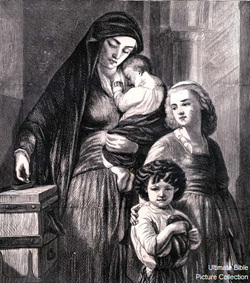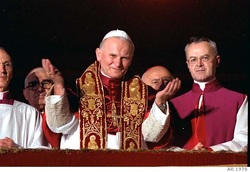
At Christmastime Holy Mother Church gives us all five Joyful Mysteries of the Rosary. A few days before Christmas we hear the Gospel of the Annunciation, and then that of the Visitation, and of course on Christmas the Nativity Story, and in two weeks, on Holy Family Sunday, the story of the finding in the Temple. Today we hear the Fourth Joyful Mystery, the Presentation in the Temple. Of course I must remind all of you to pray the rosary every day, so as to fully rejoice in these joyful mysteries. Today let’s look a little more closely at the Fourth Joyful Mystery.
Heirs
Joseph and Mary bring the baby Jesus to the Temple in obedience to the Law of Moses. They can’t afford a calf or a goat to redeem their Son, so they offer what they can afford, the offering allowed to poor people, two little pigeons. He who made the entire planet and sustains it in being at every moment was “redeemed” in his own Temple by two scrawny birds. Neither Joseph and Mary, nor the Lord Jesus Christ himself, were ashamed of their poverty. They knew they were sons of God, as St. Paul points out in the Epistle, heirs of God’s Kingdom. “When the fullness of time had come, God sent his Son, born of a woman, to ransom those under the law….you are no longer a slave but a son, and an heir…”
There is no shame in any kind of honest poverty since God took on the poverty of human flesh. Neither poverty of intellect, nor poverty of physical beauty, or poverty of money, or poverty of health or friends or social standing—no honest poverty is shameful. Shame is not found in either wealth or poverty, but in sin. We must recall always that we possess everything because we possess God, who has given himself to us. We need nothing more. “Take all that I have, O Lord. Grant me only your love and your grace,” prayed St. Ignatius, “that is sufficient for me.”
Witnesses
But back to our Story, the Fourth Joyful Mystery. Simeon, the old man in the temple, takes the baby in his arms (notice that Mary gives him the baby) and proclaims the Nunc Dimittis, prayed by all nuns and priests just before going to bed every night: “Now, O Lord, you may let your servant die in peace, for my eyes have seen your salvation and your glory” he sings, gazing down at the baby.
The child’s father and mother, we read, were amazed at what he said about the baby, but Simeon goes on, and this is where today’s Gospel begins: “Behold, this child will be the rise and the fall of many in Israel, and you yourself a sword shall pierce.” A prophetess, Anna, also glorified God about the child to all who were awaiting redemption. These two prophets, Simeon and Anna, witnessed to Christ’s Lordship, joining the Magi and the Shepherds in testimony to Christ’s divinity.
Our Lady, witness in blood
Simeon, however, witnesses also to Mary, herself the greatest witness to Christ. Not only with words but by blood will she testify. Jesus will be a sign of contradiction, but Mary’s heart also a sword shall pierce. This piercing is a joyful mystery, because God permits her to share in his saving mission. Our Lady of Sorrows, prophesied here by Simeon, maintains deep in her wounded heart the joy of suffering with Jesus. So we too, must witness unto suffering, and unto death, if He allows us. A sword will undoubtedly run some of us through in years to come. Let us pray for the strength to witness to His Lordship, come what may. “By faith,” writes Pope Benedict, “across the centuries, men and women of all ages …have confessed the beauty of following the Lord Jesus wherever they were called to bear witness: in the family, in the workplace, in public life, in the exercise of the charisms and ministries to which they were called…. The Year of Faith will also be a good opportunity to intensify the witness of charity.” Let us pray through Our Lady to witness through charity to those with whom we live, those with whom we work, those with whom we share the freeways, that Jesus Christ is Lord!











 RSS Feed
RSS Feed